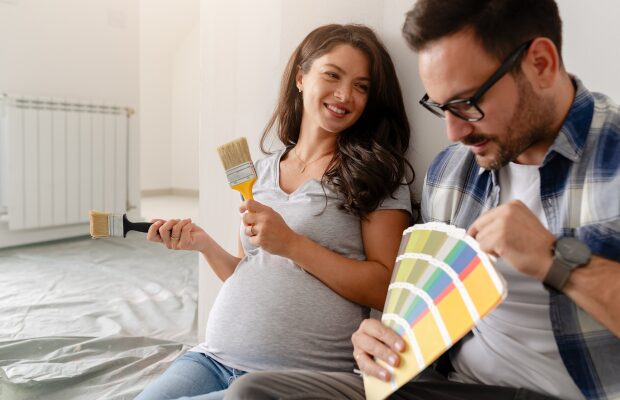A lack of square footage can make your home feel like it’s almost closing in on you.
And if you’re selling, it can certainly be off-putting for buyers – most of whom will be craving lots of space.
But it’s possible to make the rooms in your property look and feel bigger with some clever design.
Here are our nine top tips for making those small rooms in your property feel far more spacious…
1. Use colours that make a room look bigger
Colour is key to making a room feel more spacious.
Use the wrong shade and your room could feel even smaller than it is; use the right colour and it will feel airy and inviting.
Darker colours are very on trend, but in small spaces, they can absorb light and make a space feel tight and confined.
If your room is small, use lighter shades like off-whites, light blues, or greens as these will reflect light, making the space appear bigger than it really is.
2. Make a small room look bigger with flooring
Making a room feel bigger is all about tricks of the eye.
This is where hardwood or laminate flooring can really help.
And unlike dark colours on walls, deeper shades of wood flooring can actually have the opposite effect and make a room feel larger – particularly when paired with lighter wall colours.
The direction you lay your wood floor is also key.
In a square room, think about laying the planks diagonally or in a parquet style, as this creates a focal point for the eye, leading it side to side rather than directly towards another wall.
If you’re thinking of laying tiles, use bigger ones – small tiles mean lots of joins which can make a floor space feel cramped and busy.
3. Remove the clutter
Lots of clutter can make a small room feel even more congested and suffocating.
By keeping the space organised and removing large, dominating items, you can ensure your room feels open and orderly.
Look around your room with an independent eye.
Are there items of furniture that look or feel crammed in?
Could you do without those pieces, or create other storage options more aligned with the room’s square footage?
Consider removing rugs from hard floors, too, as having an open floor space will create an illusion that the room is bigger than it is.
4. Hang strategic mirrors
Filling walls of small rooms with pictures and artwork is another sure-fire way of making your space feel busy and tight.
But by hanging one or two well-placed mirrors, you can reflect light around the room and create the illusion of space.
Use your room’s focal point, for example a bed or a coffee table, and hang wall mirrors so they face it, creating a feeling of depth.
You could also consider a mirrored or glass coffee table, or mirrored doors on cabinets – all of which will help to create a sense of openness.
5. Be clever with furniture
When it comes to furniture in small rooms, there’s plenty to think about.
And size is top of the list.
Bulky furniture takes up valuable floor space, so make sure you’re using pieces that are the appropriate size for the room.
Multi-purpose furniture can work well in smaller rooms, so consider a footrest that doubles up as a coffee table or nests of tables that can be stored away when not in use.
6. Avoid heavy fabrics
Thick curtains might be great for privacy, but they can make smaller rooms feel even more cluttered.
Think about using lighter weight materials for curtains and throws or install white window shutters – these take up no space in the room itself and can help make your room feel larger.
7. Make use of vertical space
Drawing the eye up is another great trick for adding imaginary space to a small room.
A vertical shelf or even some upright wall cladding can help to emphasise the space in your room that doesn’t have furniture sitting on it.
8. Use artificial light to your advantage
In an ideal world, your small room will have plenty of natural light flowing into it, thus making it feel open and spacious.
Of course, with small spaces, this isn’t always the case – which means lighting your room in the best way you can.
In a small space, use only one main lighting fixture on the ceiling – and make it a focal point to draw the eye up.
The rest of the room should utilise lower level, directional lights like lamps, to light up the darker corners of the space and make it feel more open.
9. Less is always more
In a small room, use one major focal point – and then add accent items to complement this main feature.
So, if your living room focal point is a classic Chesterfield-style sofa, don’t draw the eye away from it by adding lots of other items to walls or shelves.
Add a small vase of flowers or a good-sized candle to your coffee table and leave it at that.
Or add one large piece of art to a wall rather than lots of grouped-together photo frames.




